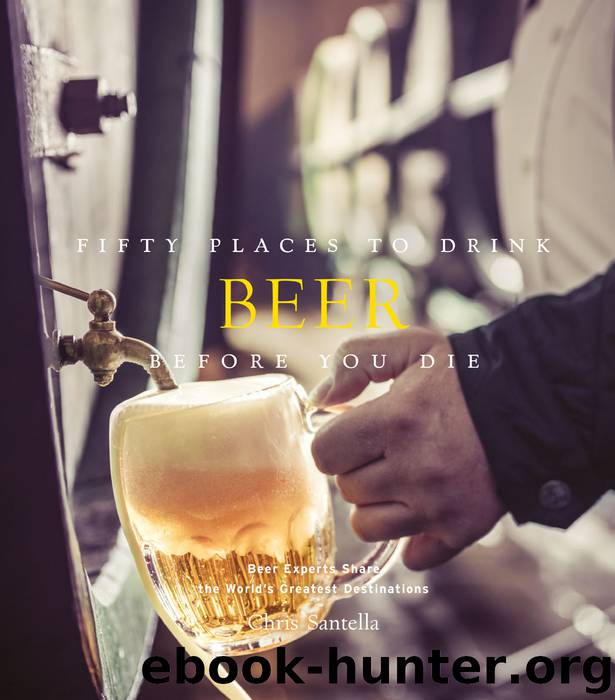Fifty Places to Drink Beer Before You Die by Chris Santella

Author:Chris Santella
Language: eng
Format: epub
Publisher: Abrams
Published: 2012-07-29T16:00:00+00:00
The Brazen Head is Ireland’s oldest pub, dating back to 1198.
Ireland
DUBLIN
RECOMMENDED BY Colm Quilligan
Writers and alcohol have often walked—perhaps stumbled—uneasily together through modern literary history. Baudelaire and Rimbaud dabbled in absinthe. Faulkner was fueled by bourbon, often in the vehicle of a mint julep. Hemingway, if his first-person narrators are any indication, could find solace in just about any spirited beverage.
Given its modest population, Ireland has enjoyed an outsize literary output, especially in the first half of the twentieth century. And Irish literary tradition has always been linked closely to the pub culture of Dublin. There’s little doubt that the cryptic dialogue of Samuel Beckett and the bon mots of Oscar Wilde were not occasionally inspired by the odd pint of Guinness. But pubs also served a more practical purpose for Irish writers of a certain time, as Colm Quilligan explained.
“It was commonplace for Dublin writers to meet editors and publishers in pubs to try to interest them in their work. This was especially true between 1930 and 1960, when the writing of so many authors was being banned. Writers could feel freer to express themselves in the convivial atmosphere of the pub. There was also the opportunity to network. The Irish are the greatest talkers the world has had since the Greeks, and the pubs provided a gregarious, almost conspiratorial atmosphere for them to talk and make connections, away from official Ireland. If you happened to have a story published in the Irish Times, you might be paid five pounds—a lot of money back then. Sometimes you would get paid in the pub, and your friends would help you spend it.”
The roots of Dublin’s pub culture date back over eight hundred years; the Brazen Head, Ireland’s oldest pub, opened its doors in 1198. While whiskey was the drink of choice in the countryside, historian Kevin Kearns notes that ale was the common beverage in Dublin by the twelfth century, with most brewed by women in their homes. It’s surmised that homes that brewed ale with a good reputation evolved into public houses as customers began to linger to consume the ale they’d purchased. By the seventeenth century, Dublin had perhaps become a bit too enchanted with its ale houses; records show that for a city with roughly 4,000 families, there were 1,180 taverns. Visitors to Dublin were taken aback by its number of drinking establishments and the general insobriety of its citizenry. (One account from the time even suggested that the crypt in Christ Church Cathedral had been converted into a tavern.) When Arthur Guinness arrived in Dublin in 1759 and signed a nine-thousand-year lease for a four-acre property at St. James’s Gate, the city was assured an even more stable flow of ale . . . an ale that would take on a darker shade. (The lease that Guinness had drawn up is on display at the brewery.)
There’s considerable debate about the origin of stout, though there’s little argument that Guinness has made the beer category its own—at
Download
This site does not store any files on its server. We only index and link to content provided by other sites. Please contact the content providers to delete copyright contents if any and email us, we'll remove relevant links or contents immediately.
| Beer | Cocktails & Mixed Drinks |
| Coffee & Tea | Homebrewing, Distilling & Wine Making |
| Juices & Smoothies | Wine & Spirits |
101 Whiskies to Try Before You Die by Ian Buxton(44911)
World's Best Whiskies by Dominic Roskrow(44824)
Whiskies Galore by Ian Buxton(41937)
Craft Beer for the Homebrewer by Michael Agnew(18194)
Right Here, Right Now by Georgia Beers(4167)
Not a Diet Book by James Smith(3373)
Water by Ian Miller(3155)
The Coffee Dictionary by Maxwell Colonna-Dashwood(3094)
Kitchen confidential by Anthony Bourdain(3046)
Coffee for One by KJ Fallon(2599)
Smuggler's Cove: Exotic Cocktails, Rum, and the Cult of Tiki by Martin Cate & Rebecca Cate(2495)
Superfood Smoothie Bowls: Delicious, Satisfying, Protein-Packed Blends that Boost Energy and Burn Fat by Chace Daniella(2419)
Beer is proof God loves us by Charles W. Bamforth(2414)
Talking as Fast as I Can by Lauren Graham(2410)
Bourbon: A Savor the South Cookbook by Kathleen Purvis(2263)
A Short History of Drunkenness by Forsyth Mark(2256)
Eat With Intention by Cassandra Bodzak(2172)
Cocktails for the Holidays by Editors of Imbibe magazine(2097)
Colombia Travel Guide by Lonely Planet(2086)
